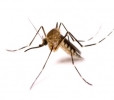
Mosquito problems are normally controllable under professional care. Our treatment goal is to stop a problem at its source so it doesn’t keep coming back. Using state-of-the art equipment and methods, our licensed exterminators will inspect your home’s environment and construction to identify the problem and determine the best course of action. Contact us today!
Mosquitoes breed on or near standing water so any standing water may become a breeding ground and only a thin layer is required for egg development. Therefore, empty cans, bird feeders, old tires, and clogged gutters may harbor these pests. Mosquitoes are also known to travel as much as 20 miles in search of a blood meals so it is safe to say that they may become a problem even in areas without standing water.
Most species of mosquitoes are nuisance pests because the female will consume animal blood to help with egg production. They are often considered one of the most dangerous pests because they help transmit many harmful human and livestock diseases. Some of these diseases include malaria, yellow fever, dengue fever, filariasis, encephalitis, and West Nile Virus. Some mosquitoes also transmit dog heartworm.
Mosquitoes will normally feed on nectar, and only the female of select species has the ability to suck blood. In addition, only mosquitoes living in certain habitats will transmit disease. This is why public health departments need to know which species, and even which strains, of mosquitoes they are dealing with in a particular area since this helps in pinpointing the exact type of mosquito and the illness they may spread.
Mosquitoes typically emerge from their daytime resting places to feed primarily at dawn and dusk. Adult mosquitoes are about 1/4 to 3/8 inch long and have color patterns due to the wings, body and legs being covered with scales. Color combinations include brown, gray, black, white and silver.
Mosquito control begins with a thorough assessment of the problem through surveys and then choosing the control measures best suited to the situation.
There are normally 3 steps to the control process and they include: